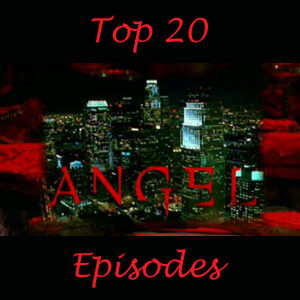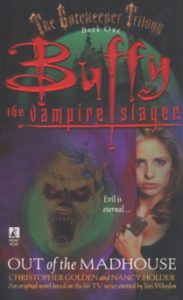In their second novel in the adult “Buffy” line, Christopher Golden and Nancy Holder continue to go against the conventional wisdom that tie-in novels should be modest. “The Gatekeeper Trilogy Book 1: Out of the Madhouse” (January 1999) launches an epic three-parter that puts Buffy and her friends through the wringer. But it’s certainly not one of those books that feels like you’re reading a fighting video game; the authors spend time with character motivations, too.
The book feels bigger (not to be confused with better) than the TV series. Its value is in how it expands the time and space of the Buffyverse. The central villain has his roots in the 1500s in France and Italy; we learn about him and the people around him through flashbacks. These passages make for smooth, engrossing reads, because neither the authors nor I am distracted by continuity issues. Setting up a mystery, it seems Fulcanelli (the sorcerer in the flashbacks) and Il Maestro (the sorcerer in the present day) are the same person, or at least connected in some way.
The overwhelming impression from my first read was how much of a physical test this is for Buffy, as she at one point fights off three vicious panthers in the titular magical house in Boston. The show was limited to Sunnydale due to its budget; hats off to Golden and Holder for not artificially limiting themselves, as we visit both Boston and New York City in “Out of the Madhouse.”
Often on the show, a monster of the week cuts into Buffy’s schooling a bit, but here it feels like being a Slayer is a full-time job — with overtime (unpaid, natch) — and the concept of fitting in schooling is laughable. The weight of Buffy’s calling is palpable, and it also strikes me how many hours even the peripheral Scoobies like Cordelia and Oz put into this.
Golden and Holder delve into side narratives that we could only wonder about on the show, such as Oz and Devon discussing the problem of Oz being absent from Dingoes gigs three nights per month. While these scenes don’t give a ton more depth to the characters, it’s kind of nice to see smaller moments in their lives.
On this re-read, I was struck (as I was with “Child of the Hunt” and “Return to Chaos”) by how many future TV story points the authors anticipated. It’s almost to the point where I wonder if some of the TV writers read these books, but I suspect these ideas are broad enough that it’s a case of multiple creative people coming up with similar ideas. For example:
- Giles meets a Watcher, Micaela Tomasi, at a librarians’ conference in New York City. He checks with council headquarters in London to make sure she’s legitimate, which is a nice callback to “Revelations” (Season 3, episode 7), where the gang is tricked by Faith’s fake new Watcher, Gwendolyn Post. The authors don’t actually reference “Revelations,” because they hadn’t seen it when they wrote this, so it’s a happy accident. If the TV show and books had been interested in working together, Micaela perhaps could’ve been used in place of Olivia, Giles’ sudden Season 4 girlfriend (potential revelations about Micaela later in this trilogy notwithstanding).
- The Scoobies are concerned about their futures, something that would be explored later in “Choices” (Season 3, episode 19). Here, Xander wants to continue to be a major helper to Buffy, similar to how Willow feels in “Choices” after she has improved her Wicca skills. But when Buffy pushes him out of the way in an opening fight, he resents that she doesn’t seem to trust him; this ties in with his later feelings of worthlessness in “The Zeppo” (13).
- When Angel travels the ghost road from Sunnydale to Boston, he is briefly haunted by Jenny Calendar, something that is more prominent in “Amends” (Season 3, episode 10), which aired around the same time as this book’s release. Additionally, at one point Angel standing on Dead Man’s Walk and anticipating the sunrise, which can’t help but make a reader think of his suicide attempt in “Amends.” He’s not at that level of depression here yet, as we see on page 140: “Angel thought about the impending sunrise and wrestled with the desire to linger and watch it. Not wrestled, exactly. He didn’t have a death wish. But a part of him yearned for it.”
- Il Maestro’s followers, the Sons of Entropy, call to mind various robed acolytes in the series, but I’m particularly reminded of the Order of Dagon, Glory’s minions and the Knights of Byzantium from Season 5, because those groups were ancient and had long-running agendas.
- The Sons of Entropy are going around the world killing Watchers, something that The First and its Harbingers of Death would later do in Season 7.
- When the gang needs to magically lend their strength to Buffy, it calls to mind the climax of Season 4, when Giles (mind), Xander (heart) and Willow (spirit) combine with Buffy (hand) to defeat Adam with an Enjoining Spell. Here it’s called a Ritual of Endowment, and it requires participation by Angel, Joyce, Oz and Cordelia as well.
As with the previous books in this line, “Out of the Madhouse” can only take place between “Revelations” (3.7) and “Lovers Walk” (3.8) because it’s the only time when 1) Joyce knows Buffy is the Slayer, 2) Everyone knows Angel is back, and 3) Xander and Cordy are still together.

Brushing off a couple references to it being almost springtime, rather than winter, it mostly works. But there is one inexplicable element: The gang doesn’t call on Faith for help. We can assume the Slayer-obsessed Sons of Entropy simply don’t know about Faith.
But there are several moments in this book where the Scoobies worry about balancing their forces between Boston, where they must check on the Gatekeeper, and Sunnydale, where the unusually high number of monsters must be kept at bay. Faith’s absence in “Child of the Hunt” and “Return to Chaos” can be explained by the relative smallness and brevity of those stories (after all, she does sit out some episodes of Season 3). But the “Gatekeeper Trilogy” is so epic that it seems the gang should seek Faith’s assistance, despite lingering awkwardness from “Revelations,” where – tricked by Gwendolyn Post — she tries to kill Angel.
The real-world reason, I surmise, is that Joss Whedon’s office gave Golden and Holder – who presumably wrote this in the summer of 1998 – only two pieces of information about Season 3: 1) that Angel would return to normal, and 2) that Buffy and her mom would work through the fact of Buffy’s Slayer calling. They were not told that Xander and Cordy would break up and, more notably, they were not told about Faith.
The withholding of the latter point is a shame because Faith would’ve fit wonderfully in this narrative. For one thing, she is from Boston; for another, in Season 3 she chafes at Sunnydale’s smallness and longs for a big, epic fight. It would’ve been nice to have a glorious Buffy-Faith team-up before things go to hell with their relationship.
While Faith isn’t in “Out of the Madhouse,” Spike is. In the final chapter, we learn he is bargaining with Il Maestro, holding the Gatekeeper’s heir in exchange for a powerful artifact that Drusilla desires. This works in continuity, because the last time we saw Spike – near the end of Season 2 – he had fulfilled his bargain with Buffy and run off with Dru.
The next time we see him, in “Lovers Walk,” he’s distraught over Drusilla leaving him for a chaos demon. Golden and Holder could’ve tied that nugget into this story – wherein Il Maestro aims to bring chaos back to Earth — had they only seen “Lovers Walk” ahead of time. I suspect there will be no such tie-in in the last two books, but it seems the continuity should still hold up, as we can imagine Dru leaves Spike after the events of this trilogy.
Click here for an index of all of John’s “Buffy” and “Angel” reviews.

